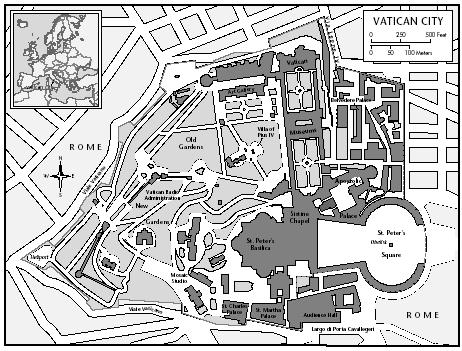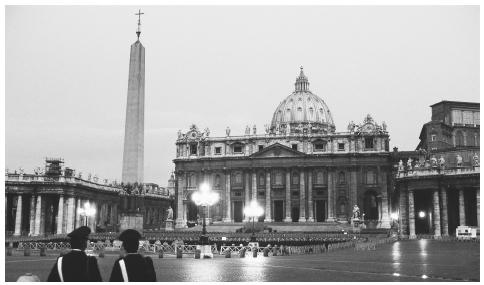Culture Name
VaticanAlternative Names
Holy See, the VaticanOrientation
Identification. The Vatican, or Vatican City, is the center of Roman Catholicism and the residence of the bishop of Rome (the pope). The popes controlled the Papal States in what is now Italy throughout most of the Middle Ages. On 13 May 1871, the new Italian state restricted the pope's temporal authority to the Vatican and Lateran areas of Rome and the rural retreat of Castel Gandolfo. The popes refused to accept the validity of this law until the Concordat of 11 February 1929 gave the Catholic Church special status in Italy and paid an indemnity to the now independent Vatican City.Location and Geography. The Vatican's 108.7 acres are completely surrounded by Rome.
Demography. There are about 850 Italian and Swiss permanent residents, along with lay workers from Catholic communities around the world.
Linguistic Affiliation. The major languages are Italian and Latin.
Symbolism. The pope represents a link to Saint Peter and Jesus. Vatican ceremonies recall the words and actions of Jesus and his followers. Candles, incense and various rituals carry symbolic meaning. The Vatican is a symbol of Church leadership and its apostolic tradition.
History and Ethnic Relations
Emergence of the Nation. The Vatican is a successor to the Papal States, which made up a large area of central Italy. After the unification of Italy, the new state annexed the Papal States after Germany defeated France, which had protected the pope's interests, in the Franco-Prussian War (1870–1871). The popes refused to leave, declaring themselves "Prisoners of the Vatican," until Benito Mussolini signed agreements in 1929 granting the Church special privileges in Italy and a cash settlement. The Vatican was given independence under papal rule. Since that time, the Vatican has been an independent state that sends and receives ambassadors.National Identity. The Vatican's identity is religious, not national. It presents itself as transnational and universal.
Ethnic Relations. The Vatican has sought ties with members of all ethnic groups as part of its universal religious identity.
Urbanism, Architecture, and the Use of Space
The Vatican is entirely urban. It has many artistic and architectural masterpieces, including Saint Peter's Cathedral and the Sistine Chapel. Despite its small area, there is a sense of openness and comfort.Food and Economy
Food in Daily Life. The major food style is that of Rome. Like other Italians, residents of the Vatican consider their cooking the best in the world. Pope John Paul II caused a furor when he requested Polish cooking from the papal chef.Food Customs at Ceremonial Occasions. On New Year's Eve, the Italian tradition is to have the meal of the seven fishes, including eels, conch, and squid. Lamb is a traditional Easter dish. For each of these meals, there is always a pasta course.

Vatican City
Land Tenure and Property. The Church owns all property in Vatican City and areas outside the Vatican covered by extraterritorial rights.
Division of Labor. The Curia rules the Church under the pope. Its members come from countries around the world and work in many governmental departments. The pope presides over the bureaucracy, delegating and consulting with his subordinates. The heads of the important bureaus tend to be cardinals.
Social Stratification
Classes and Castes. The Vatican is highly stratified. The pope is at the apex of the hierarchy and cardinal-archbishops, bishops, monsignors, priests, and others come below him, followed by the heads of bureaus. Lay workers generally rank below the clergy.Symbols of Social Stratification. Clerical dress marks a person's rank. The pope's white robes distinguish him clearly. Cardinals wear red, and other ranks are noted by their style of dress and rings. Style of clothing, place in a procession line, and seating are also marks of social position.
Political Life
Government. The basic law is the Code of Canon Law. Church councils meet approximately once per century. Bishops' synods meet periodically and offer advice, but the day-to-day running of the Vatican
The Piazza San Pietro at night. The Piazza is the site of public masses and worldwide papal addresses.
Social Problems and Control. There is little crime, and the typical problems are disputes over religious doctrine and governance. Strict statements and actions regarding conformity to doctrine, including censorship and the silencing of dissidents, have alternated with attempts at persuasion and expressions of conciliation.
Military Activity. The Vatican is officially neutral in world affairs but can mediate disputes if invited to do so. Swiss guards in medieval uniforms protect the pope and the city.
Social Welfare and Change Programs
There are social welfare programs for employees. Catholic charity organizations promote social welfare and change throughout the world.Nongovernmental Organizations and Other Associations
In the Vatican, there are no distinctions between church and state. The Vatican works with many secular organizations.Gender Roles and Statuses
The ethos is male-dominated. There have been efforts toward greater gender equality, especially on the part of nuns. However, as long as the priesthood is reserved for males, it will be difficult to achieve such equality. Men hold the vast majority of key positions.Marriage, Family, and Kinship
The married people in the Vatican are mainly commuting workers whose family arrangements are the same as those in Italy.Etiquette
The Vatican insists on modest and appropriate dress in its sacred places. Quiet is enjoined in sacred areas, and deference to the clergy is expected. There is strict adherence to speaking only when addressed and deferring to senior officials.Religion
Religious Beliefs. The Vatican is a Catholic state whose population is virtually 100 percent Roman Catholic. There is a belief in heaven and hell and in just rewards or punishments for one's actions on earth. There is a belief in a supreme triune God, and various saints are honored. The final judgment and resurrection of the dead are tenets of the faith.Religious Practitioners. The Catholic clergy are the major religious practitioners and can administer the seven sacraments, depending on their rank. Bishops can ordain other priests.
Rituals and Holy Places. The Vatican is a treasure trove of special buildings and shrines. Saint Peter's is the site of Peter's tomb and is built over the original basilica. The Sistine Chapel in the church features the ceiling painted by Michelangelo. The Lateral Palace, once the home of the popes, is another magnificent building. Saint Peter's Square is known around the world, and the pope often addresses the world from the square. It is also the site of many of his public masses. The religious calendar of the Catholic Church is followed, along with the rituals appropriate to that calendar.
Death and the Afterlife. The beliefs of the Catholic Church in a life after death, the existence of Purgatory, and the efficacy of prayers for the dead are followed.
Medicine and Health Care
The Vatican has an up-to-date health care system that draws on specialists from around the world.Secular Celebrations
There are no secular holidays. The major religious feasts are Christmas and Easter, and there are other major holy days and feast days of saints.The Arts and Humanities
The Church has a long history of supporting the arts. The Vatican is among other things a museum. Its library is a major source of knowledge about the Renaissance and European history.The State of the Physical and Social Sciences
The Vatican is more interested in social sciences than physical sciences. It is not opposed to the physical sciences and has stated its general support for the physical sciences and their compatibility with religion. Within the Vatican, there has been more immediate application of the social sciences, particularly sociology, psychology, and political science.Bibliography
"Future Doubtful for Bishops' Conferences." America 179 (4): 3, 1998.Hersey, George L. High Renaissance Art in St. Peter's and the Vatican: An Interpretive Guide , 1993.
Hutchinson, Robert J. When in Rome: A Journal of Life in the Vatican , 1998.
McDowell, Bart, James L. Stanfield, Elizabeth L. Newhouse, and Charles M. Kogod, eds. Inside the Vatican , 1993.
Reese, Thomas. Inside the Vatican , 1996.
Roncalli, Francesco. Vatican City: Vatican Museums , 1997.
Steinfels, Margaret O'Brien. "How the Vatican Works: An Interview with Thomas J. Reese." Commonweal , 123 (4): 10–13, 1996.
Stickler, Alphonso. The Vatican Library: Its History and Treasures , 1989.
0 comments: